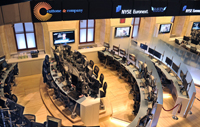Having a seat on the floor of the New York Stock Exchange has taken on new meaning since the Big Board opened its next-generation trading floor in the Main Room last month.

Traders now can enjoy the privilege of sitting in an actual seat, which is new for them, but something upstairs traders have done for decades. The redesign updates the floor with technology upstairs desks have always had, said Bob Airo, senior vice president for market operations at NYSE.
The NYSE’s upgraded trading desks make it attractive for brokers to move upstairs operations downstairs, Airo said. In some cases, firms have consolidated their upstairs and floor operations. The benefit is clear: lower overhead and greater efficiencies through a centralized desk.
"Cuttone & Co. has already combined its upstairs and downstairs trading desks, and MND Partners will do the same," Airo said. Direct Access Partners and Barclays Capital are moving into the renovated spaces soon.
Neil Catania, chief executive officer of MND Partners, on the exchange since 1981, said the NYSE redesign is an improvement.
"I haven’t had a chair in 28 years and won’t know what to do with one," Catania said. "As a floor broker, I spend more time in the middle of the floor, but as the markets have changed, there are times now when I’ll be sitting down."
The chairs stand in stark contrast to the by-gone days of being shoulder-to-shoulder with fellow traders. The new spot gives him a luxury he never had in his 1930’s era booth–breathing space. This new layout stopped him from forming an upstairs tradng desk at 14 Wall Street.
"When there is verbal communication with the trader right behind you, there’s no delay in getting an order done, said Catania."
Even firms that were skeptical about combining upstairs desks and floor traders are reconsidering the NYSE’s new design. Airo said one firm that was initially resistant to consolidating upstairs and floor operations has now requested Main Room or Garage space to combine its trading desks.
Back in the 1990s, NYSE launched a similar program to upgrade floor booths. It rolled out so-called Super Booths for several large firms. The Super Booths were like an upstairs trading desk–roomier and offering better technology–than typical cramped brokerage booths.
The concept didn’t spread beyond the first prototypes, due to a lack of space. At the time, the exchange held roughly an 80 percent market share of its stocks, in sharp contrast to today’s 25 percent share.
When done, the exchange’s 30,000 square foot Main Room will house 15 trading pods, each seating 10 to 40 traders. The west wall will be completed by June and the east wall by late November or early December.
The new booths, designed by Perkins Eastman PC, provide room for up to six video screens per workstation and are 28 inches wide by 24 inches deep, up from 18 inches wide and 12 inches deep.
The next phase of modernization will be the 7,500-square-foot Garage in 2011. Designs are being looked at to provide a minimum 250 trader spots. Several firms have expressed interest, but Airo said no tenant agreements have been signed.
There are 100 firms in the Main Room and Garage.
Preliminary renovation plans for the Main Room’s north and south walls are also on the drawing board, Airo said.
The Main Room includes a new infrastructure network that supports members’ own trading applications and NYSE broker applications. This enables firms to use the same systems and personnel on and off the floor.
The main floor renovation will cost $7.5 million, Airo said. Firms will pay a one-time fee of $12,000 per work station and no additional seat fees for a minimum three years. Garage space pricing hasn’t been set.
(c) 2010 Traders Magazine and SourceMedia, Inc. All Rights Reserved.
http://www.tradersmagazine.com http://www.sourcemedia.com/





